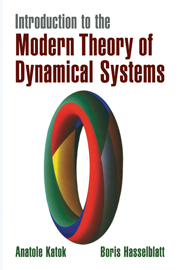Book contents
- Frontmatter
- Contents
- PREFACE
- 0 INTRODUCTION
- Part 1 Examples and fundamental concepts
- Part 2 Local analysis and orbit growth
- Part 3 Low-dimensional phenomena
- Part 4 Hyperbolic dynamical systems
- 17 SURVEY OF EXAMPLES
- 18 TOPOLOGICAL PROPERTIES OF HYPERBOLIC SETS
- 19 METRIC STRUCTURE OF HYPERBOLIC SETS
- 20 EQUILIBRIUM STATES AND SMOOTH INVARIANT MEASURES
- 21 Supplement: DYNAMICAL SYSTEMS WITH NONUNIFORMLY HYPERBOLIC BEHAVIOR BY ANATOLE KATOK AND LEONARDO MENDOZA
- Appendix: BACKGROUND MATERIAL
- NOTES
- HINTS AND ANSWERS TO THE EXERCISES
- REFERENCES
- INDEX
21 - Supplement: DYNAMICAL SYSTEMS WITH NONUNIFORMLY HYPERBOLIC BEHAVIOR BY ANATOLE KATOK AND LEONARDO MENDOZA
Published online by Cambridge University Press: 05 June 2012
- Frontmatter
- Contents
- PREFACE
- 0 INTRODUCTION
- Part 1 Examples and fundamental concepts
- Part 2 Local analysis and orbit growth
- Part 3 Low-dimensional phenomena
- Part 4 Hyperbolic dynamical systems
- 17 SURVEY OF EXAMPLES
- 18 TOPOLOGICAL PROPERTIES OF HYPERBOLIC SETS
- 19 METRIC STRUCTURE OF HYPERBOLIC SETS
- 20 EQUILIBRIUM STATES AND SMOOTH INVARIANT MEASURES
- 21 Supplement: DYNAMICAL SYSTEMS WITH NONUNIFORMLY HYPERBOLIC BEHAVIOR BY ANATOLE KATOK AND LEONARDO MENDOZA
- Appendix: BACKGROUND MATERIAL
- NOTES
- HINTS AND ANSWERS TO THE EXERCISES
- REFERENCES
- INDEX
Summary
Introduction
The purpose of this work is to present some of the key ideas, methods, and applications of the theory of smooth dynamical systems with nonuniformly hyperbolic behavior, often called the Pesin theory due to the landmark work of Va. B. Pesin in the mid-seventies [Pes1], [Pes2], [Pes3]. The central idea of the theory is the combination of the hyperbolic behavior for the linearized system, which can be sharpened and amplified by the crucial technical devices of the Lyapunov metric (see Section S.2d) and regular neighborhoods (Definition S.3.3), with the presence of nontrivial recurrence, an essentially nonlinear phenomenon. This combination produces a rich and complicated orbit structure manifested by the growth of the number of periodic orbits at an exponential rate determined by entropy, the presence of large hyperbolic invariant sets of the horseshoe type, the determination of cohomology classes of Hölder cocycles by periodic data, and so forth. By the classical theorem of Luzin the hyperbolic estimates (which are obviously given by Borel functions) are uniform on a set of large measure. Controlling the recurrence on such a set allows us to produce the aforementioned phenomena. Remarkably, a considerable part of the theory can be developed without constructing the families of stable (contracting) and unstable (expanding) manifolds which are usually presented as the cornerstone of the subject. Instead it is sufficient to use their approximations, admissible manifolds (see Definition S.3.4), which can be constructed in a straightforward fashion.
- Type
- Chapter
- Information
- Introduction to the Modern Theory of Dynamical Systems , pp. 657 - 700Publisher: Cambridge University PressPrint publication year: 1995
- 2
- Cited by



